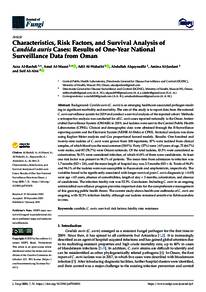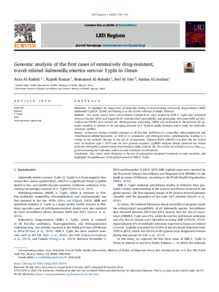Document
Characteristics, risk factors, and survival analysis of candida auris cases : Results of one-year national surveillance data from Oman.
Identifier
DOI: 10.3390/jof7010031
Source
Journal of Fungi. v. 7, 1, 31, p. 1-12
Contributors
Al-Maaniyah, Amal., Author
Al-Wahaibi, Adil., Author
Al-Qayoudhi, Abdullah., Author
Al-Jardaniyah, Amina., Author
Al-Abri, Seif., Author
Country
Switzerland
City
Basel
Publisher
MDPI AG.
Gregorian
2021-01-01
Language
English
Subject
English abstract
Background: Candida auris (C. auris) is an emerging healthcare-associated pathogen result-ing in significant morbidity and mortality. The aim of this study is to report data from the national C. auris surveillance system for 2019 and conduct a survival analysis of the reported cohort. Methods: a retrospective analysis was conducted for all C. auris cases reported nationally to the Oman Antimicrobial Surveillance System (OMASS) in 2019, and isolates were sent to the Central Public Health Laboratories (CPHL). Clinical and demographic data were obtained through the E-Surveillance reporting system and the Electronic System (NEHR Al-Shifa) at CPHL. Statistical analysis was done using Kaplan–Meier analysis and Cox proportional hazard models. Results: One hundred and twenty-nine isolates of C. auris were grown from 108 inpatients; 87% were isolated from clinical samples, of which blood was the most common (38.9%). Forty (37%) were ≥65 years of age, 72 (66.7%) were males, and 85 (78.7%) were Omani nationals. Of the total isolates, 43.5% were considered as colonization; 56.5% were considered infection, of which 61.8% of them were candidemia. At least one risk factor was present in 98.1% of patients. The mean time from admission to infection was 1.7 months (SD = 2.8), and the mean length of hospital stay was 3.5 months (SD = 4). Totals of 94.8% and 96.1% of the isolates were non-susceptible to fluconazole and amphotericin, respectively. The variables found to be significantly associated with longer survival post C. auris diagnosis (p 0.05) were age 65 years, absence of comorbidities, length of stay 3 months, colonization, and absence of candidemia. The infection fatality rate was 52.5%. Conclusion: Including C. auris in an ongoing antimicrobial surveillance program provides important data for the comprehensive management of this growing public health threat. The current study shows health care outbreaks of C. auris are ongoing, with 52.5% infection fatality, although our isolates remained sensitive to Echinocandins in vitro.
ISSN
2309-608X
Resource URL
Category
Journal articles


